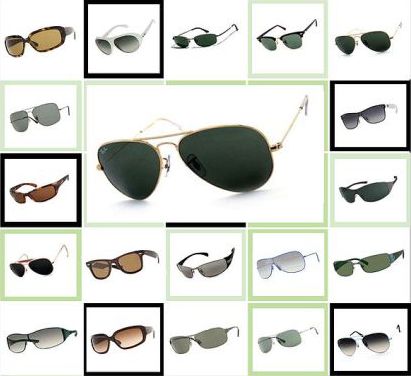With the rapid technological advancements, it is easy to forget the significant inventions of years past. However, since the 1700’s, only a few modifications have altered the basic design of today’s eyewear. The development of contact lenses eliminated the awkward frames of glasses, but at the expense of frequent replacement and eye irritation. Now laser surgery may eliminate the need for contacts. Despite the continuous evolution of vision correction, one thing remains certain: the same optical principles will continue to govern developing products, no matter what form they take!
Introduction
The role of eyewear cannot be underestimated in today’s society. Millions of people use glasses each day to overcome eye deficiencies and improve the quality of their vision. While some despise their appearance, many find glasses an essential aid for day-to-day life. For those concerned with their image, contacts provide an aesthetic alternative that offers improved vision without the frames. Still others enjoy the fashion of sunglasses, with their stylish design also functioning to block the sun’s rays. Although many innovations are taken for granted, behind every set of frames and lenses lies a feat of engineering design. This article investigates the properties that make glasses, contact lenses, and sunglasses overcome common vision problems.
A Brief Background on the Eye
The eye is the critical link that translates light from the environment into the visions our brain perceives. By expanding and contracting in response to environmental conditions, the pupil regulates the amount of light to enter the eye. In dark environments, the pupil expands to allow the maximum amount of light to enter the cornea. In bright areas, the pupil contracts to limit the amount of light to enter. Light enters through the glasses, contact lenses, and sunglasses overcome common vision problems.
Light enters through the eye’s covering, the cornea, and passes through the lens. Muscles in the eye can change the structure of the lens, making it more or less spherical in accordance with the environment. The light ray changes angle in response to the muscular contraction, and the light bends onto the retina. Located at the back surface of the eye, the retina is the site where the nervous system translates the light signal into a form that can be interpreted by the brain. Vision problems arise when either the lens is unable to bend light onto the retina, or the retina is unable to translate the light into a signal that can be interpreted by the brain. Heredity, eyestrain or a variety of other problems or injuries may cause the retina to lose its ability to properly handle light.
Problems Afflicting the Eye and Vision
Today’s most common problems include near-sightedness (myopia), far-sightedness (hyperopia), and astigmatism (visual distortion from the cornea). With age, the lens of the eye hardens, accounting for the vision problems frequently encountered by the elderly. A hardened lens is unable to respond adequately to the muscular contractions of the tissue surrounding the eye. As a result, light fails to reach the precise portion of the retina needed for clear vision.
Nearsightedness occurs because distant light rays are refracted in front of the retina, rather than onto the retina. The result is a blurred image for objects at a distance, but clear vision for objects near the viewer. Just the opposite occurs with farsightedness, where a person sees objects at a distance clearly but has difficulty viewing objects up close. Hyperopia (farsightedness) occurs when the eyeball is shorter than normal. Because the retina is farther inward the lens is unable to focus properly.
A third common ailment is astigmatism, which causes blurred vision. Astigmatism differs from myopia and hyperopia in that it develops in the cornea rather than onto the retina. An irregularly shaped cornea is the primary cause, producing blurred vision that can result in headaches and eyestrain. A normal cornea is spherically shaped; astigmatism develops as the curvature varies from its normal shape. While laser surgery can be used to reshape the cornea into a sphere, glasses can also be used to alter the way the eye receives light.
Glasses
Since the 13th century, glasses have been used for vision correction. Glasses are designed to overcome visual problems by using a single external lens to take the role of the eye’s natural lens. In 1774, Benjamin Franklin enhanced the 500-year-old design of spectacles by developing bifocals for his own personal use (see Fig. 1).

Print by the Detroit Publishing Company, after painting by Charles Willson Peale./Wikimedia Commons
Figure 1: Benjamin Franklin enhanced glasses by developing bifocals for his personal use.
Bifocals, as their name implies, have divided lenses for each eye. The divided lens corrects vision for objects both near and far, addressing both problems of myopia and hyperopia. Since these basic inventions, scientists and engineers have continued to narrow the gap between perfect, natural vision, and corrected vision. Today’s eyewear products also reduce blurriness and increase clarity of vision with special coatings that transform light into a form that is more comfortable for the eye to see.
The Physics of Vision Correction
Vision correction, based on the principles of optics, works by correcting the pathway light follows in the eye. Light slows as it enters a material, resulting in a bend called refraction. When imperfections arise in the eye, whether from heredity or from nearsightedness, farsightedness, or astigmatism, light will no longer refract properly onto the eye’s back surface, causing unclear vision. Glasses work because an external lens directs light to the retina when the eye’s lens fails to perform the task adequately. Glasses do the eye’s work by focusing the light before it enters the eye, so that the retina properly receives an image.
Like a car running head-on into a wall, light hits an object at a right angle to its surface. Focus occurs as light passes through a lens, is bent, and converges to a point. The lens curvature directs the light in the desired direction, usually onto a retina that is not receiving light properly. Spherically-shaped lenses keep the radius of curvature constant. Since light rays are kept separate by the constant radius of curvature, the spherical design offers optimal focus to correct for the problems associated with both myopia and hyperopia [1]. Custom lenses can be manufactured to emulate a spherically-shaped cornea for those suffering from astigmatism. Lenses bend incoming light with their convex or concave shape. Convex lenses bulge outward, causing the light to converge at what is called a focal point. On the other hand, concave lenses curve inward, causing light to be projected onto a larger surface area. When light reaches the outside of a convex lens, it is refracted, and continues through the medium.
Convex lenses have a focal point behind the lens. The location of the focal point behind the lens varies with the length of the lens and the radius of curvature. By changing the properties of the lens, a focal point to correct myopia or hyperopia can be produced. The critical difference between myopia and hyperopia is the angle needed to view an object, which is proportional to distance. Near-sightedness is treated with glasses or contact lenses that utilize a refracting lens to compensate for the elongation of the eye. Objects far away require less of an angle of vision than objects up close. By moving the focal point inward, the angle is reduced. Moving the focal point away from the eye and towards the lens increases the angle [2].
Proper screening is necessary in order to calibrate the lens for each individual’s eye. While lens design is certainly the most important aspect in the success of a pair of glasses, engineers must also meet the demands of consumers. In designing a marketable product, durability, safety, and cosmetic appeal become significant factors. Although the proper angle and glass are necessary to correct vision problems, shatter resistance and other accessory features are just as important to consumers. While designed similarly to glasses, contact lenses and sunglasses contain the many extra features demanded by an image and health-conscious public [3].
Further Applications – Contact Lenses and Sunglasses
While glasses are designed almost exclusively for vision correction, contacts appeal to customers seeking a natural look. Contact lenses are more intricate than glasses because their design takes into account the delicate surface of the eye and friction caused by contact. Since the contact lens is designed for placement directly on the eye, engineers must produce a design that enhances vision without sacrificing user comfort.
Johnson and Johnson, with their ACUVUE line of disposable contacts, brings together a wide array of engineering principles into a convenient format that meets the needs of those with vision problems. To resolve the issue of intense wear-and-tear, Johnson and Johnson created their ACUVUE lenses to be replaced daily. For a choosy public, the company designed the lens to have an optional Ultraviolet (UV) blocker, formed by chemically applying several layers of film to the outer surface of the lens. Designed by chemical engineers, the material increases the absorption of light wavelengths, especially near 450 nanometers, the wavelength of ultraviolet radiation. Like the ACUVUE contact lenses, today’s sunglasses now protect against ultraviolet radiation by including the thin film coating over the lens (see Fig. 2). Absorbing the wavelengths of ultraviolet light near 450 nanometers, sunglasses prevent harmful rays from reaching the cornea, where damage often begins. In fact, doctors now believe that long-term sunglass use will help to ensure healthy eyes [4]
Sunglasses stand out for the tint that darkens the light of the sun. The darker lenses are created with vertical polarization, a technique used to filter out horizontally vibrating light (see Fig. 2). Streaking the lens with thinly spaced parallel line creates vertical polarizations. Any light rays that do not fall directly through the narrow vertical crevices are blocked out. Polarizing the lens reduces the amount and intensity of the light, thereby reducing eyestrain. Designed for both style and functionality, sunglasses provide a sleek look while also reducing the glare that originates on horizontal surfaces. With these added features appealing to popular culture, sunglasses have become a multimillion-dollar industry [5,6,7,8,9].

Roger Lacocoa/Wikimedia Commons
Figure 2: Sunglasses protect against ultraviolet radiation by including a thin film coating over the lens.
Conclusion
The sunglasses industry is providing the style consumers demand, and laser surgery is emerging as the preferred method for treating eye problems. Applying a laser directly to the surface of the eye, the light beam is able to eliminate imperfections on the cornea, providing the best solution for eliminating astigmatism. By resurfacing the outer eye, laser surgery is bringing the benefits of traditional eyewear directly to the eye, without the need for extra materials. With the rapid technological advancements, it is easy to forget the significant inventions of years past. However, since the 1700’s, only a few modifications have altered the basic design of today’s eyewear. The development of contact lenses eliminated the awkward frames of glasses, but at the expense of frequent replacement and eye irritation. Now laser surgery may eliminate the need for contacts. Despite the continuous evolution of vision correction, one thing remains certain: the same optical principles will continue to govern developing products, no matter what form they take!
References
-
- [1] CIBA Vision Worldwide. CIBA Vision CustomEyes. Internet: http://procare.cibavision.com/pdf/o2custom_techaid.pdf.
- [2] American Academy of Opthalmology. Eyenet Magazine. Internet: http://www.aao.org/aao/publications/eyenet/201103/index.cfm?CFID=6825659&CFTOKEN=24461150.
- [3] S. Beeson. “Light, Reflection and Refraction.” Arizona State University. Internet: acept.asu.edu/PiN/mod/light/reflection/pattLight1.html, 1995.
- [4] S. Beeson. “How do lenses make things look bigger or smaller?” Arizona State University. Internet: www-distlearn.pp.asu.edu/patterns/PiN/mod/light/lenses/pattLight2Obj2.html, 1995.
- [5] Canadian Ophthalmological Society. Internet: http://www.eyesite.ca/about/aboutCOS_e.php.
- [6] L. Day and I. McNeil.Biographical Dictionary of the History of Technology. New York: Routledge Reference, 1996.
- [7] Essilor Laboratories. Internet: www.customeyesinc.com.
- [8] P. Hewitt. Conceptual Physics. Eighth Edition. New York: Addison-Wesley, 1998.
- [9] Johnson and Johnson. Internet: http://www.jnj.com/connect/.



